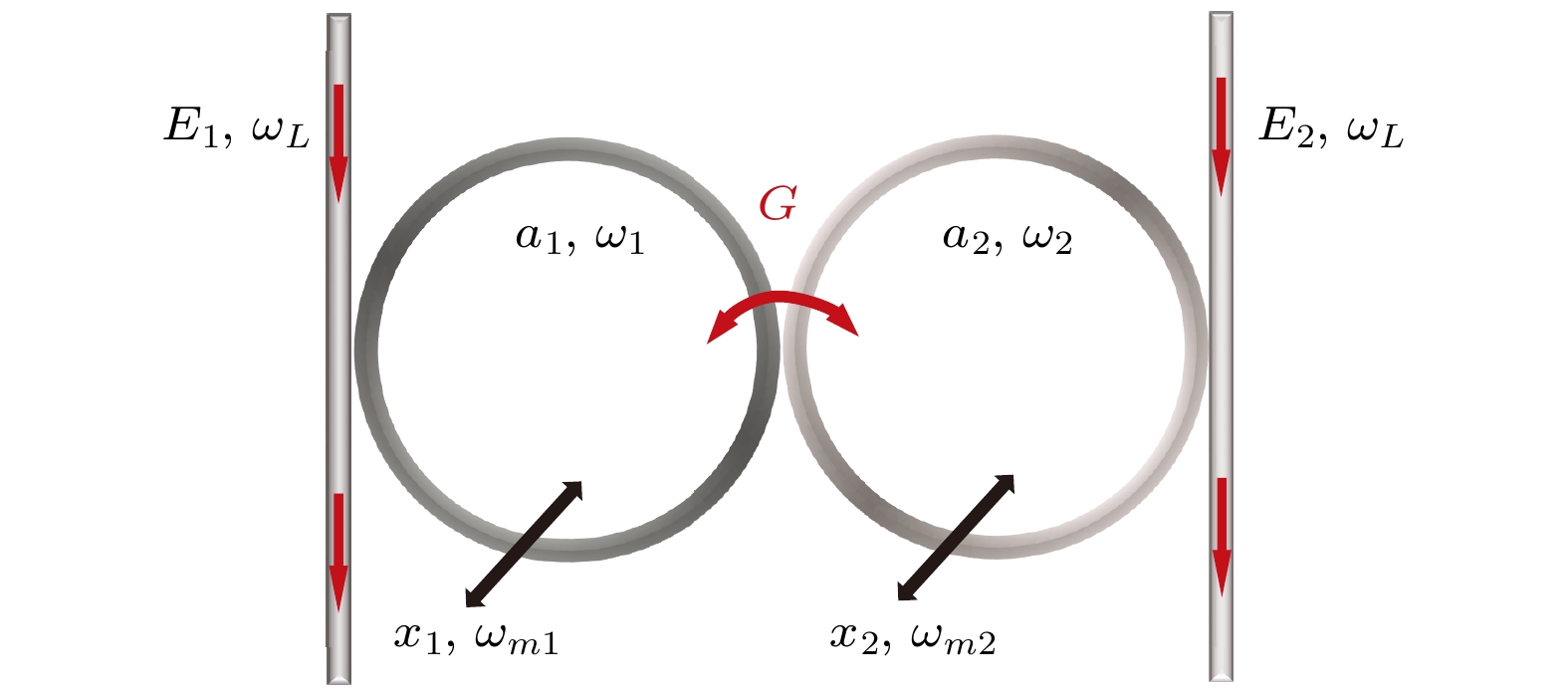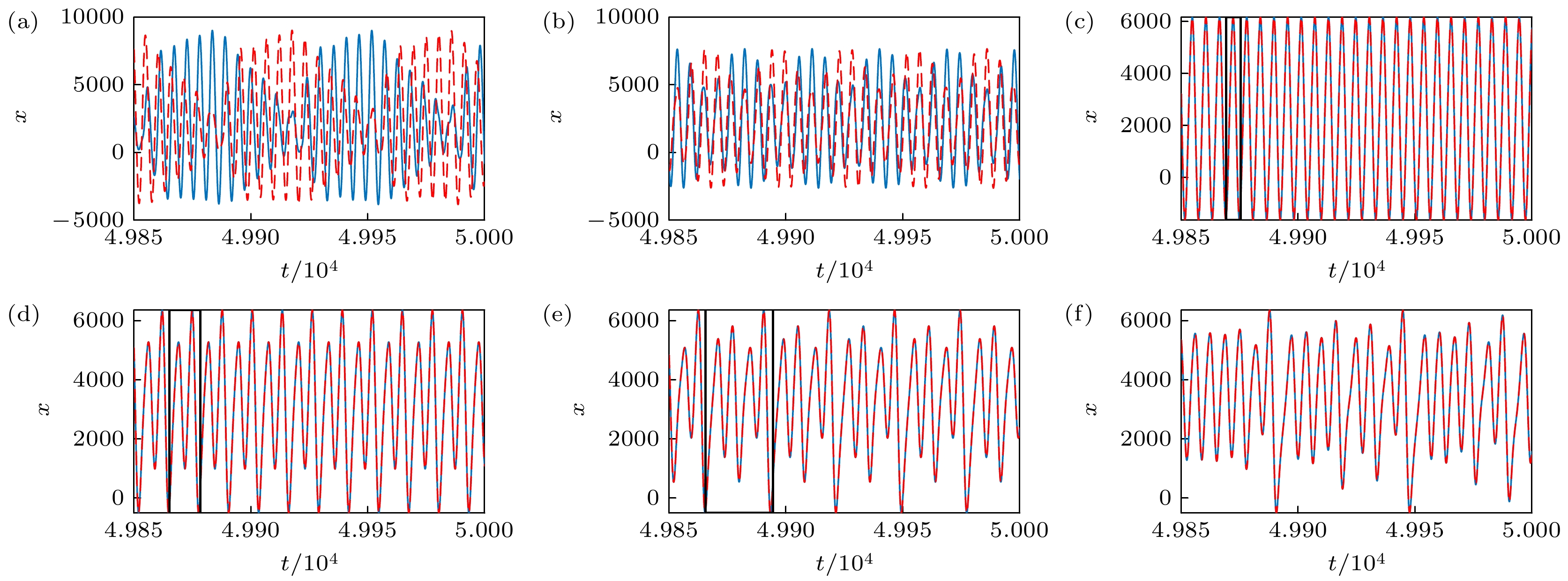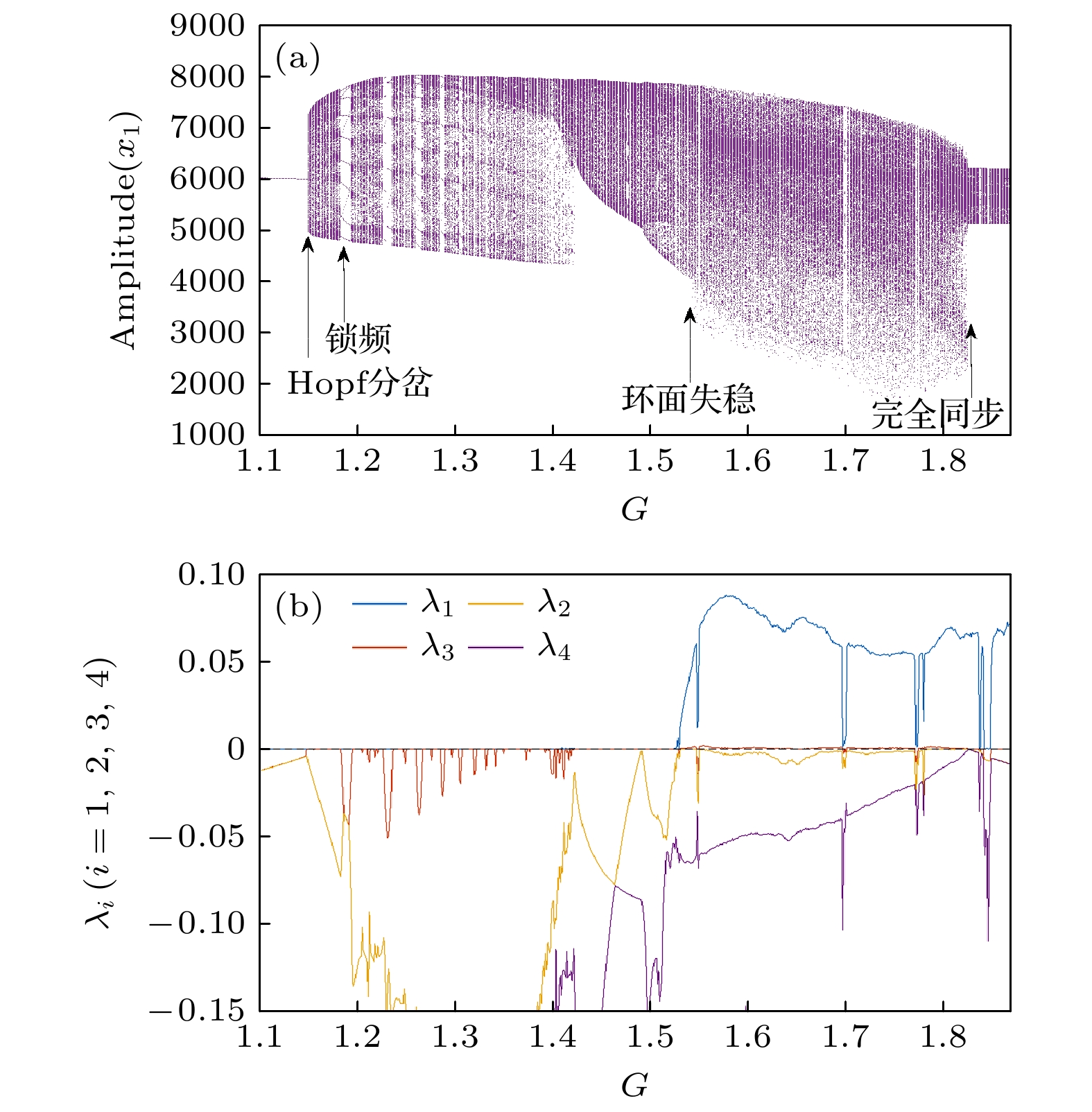-
In opto-mechanical systems, the nonlinearity caused by radiation pressure can lead to various abundant dynamical phenomena such as chaos. Chaos is an important branch of nonlinear dynamics, and researchers focus on understanding the transitions from order to chaos in different systems. In this paper, we investigate the chaotic dynamics in a system consisting of two evanescently coupled identical cavity opto-mechanical subsystems, where the optical fields are in whispering gallery modes. To thoroughly analyze the transition from order to chaos in our system, we utilize the bifurcation diagrams, the Lyapunov exponents, and phase space trajectories to characterize the system properties. It is found that the coupling strength between the two opto-mechanical subsystems plays a crucial role in determining the systemic dynamic behaviors. There are two routes to chaos in our system i.e. the period-doubling transition and the quasiperiodic transition. These routes correspond to strong coupling and weak coupling between the two opto-mechanical subsystems, respectively. Furthermore, the results show that the synchronization between the oscillations in the two opto-mechanical subsystems can occur under strong coupling. In this situation, the dynamic behaviors of the two opto-mechanical subsystems are exactly identical and the manipulation of the coupling strength is equivalent to the tuning of the frequency detuning between the cavity fields and their corresponding driving fields. Consequently, the coupled system behaves as a single opto-mechanical system, enabling a period-doubling transition to chaos through increasing the coupling strength. In the case of weak coupling, the dynamics of the two opto-mechanical subsystems are no longer synchronized, and the coupled system dynamic behaviors unfold in an eight-dimensional phase space. The limit cycles experience the Hopf bifurcation, resulting in the emergence of a toric attractor. Within a certain range of parameters, i.e. appropriate frequency detunings, the two-dimensional torus becomes unstable as coupling strength increases, leading to a quasiperiodic transition into chaos in our coupled opto-mechanical system.
[1] Aspelmeyer M, Kippenberg T J, Marquardt F 2014 Rev. Mod. Phys. 86 1391
 Google Scholar
Google Scholar
[2] Marquardt F, Chen J P, Clerk A A, Girvin S M 2007 Phys. Rev. Lett. 99 093902
 Google Scholar
Google Scholar
[3] Wilson-Rae I, Nooshi N, Zwerger W, Kippenberg T J 2007 Phys. Rev. Lett. 99 093901
 Google Scholar
Google Scholar
[4] Vitali D, Gigan S, Ferreira A, Böhm H R, Tombesi P, Guerreiro A, Vedral V, Zeilinger A, Aspelmeyer M 2007 Phys. Rev. Lett. 98 030405
 Google Scholar
Google Scholar
[5] 张秀龙, 鲍倩倩, 杨明珠, 田雪松 2018 物理学报 67 104203
 Google Scholar
Google Scholar
Zhang X L, Bao Q Q, Yang M Z, Tian X S 2018 Acta Phys. Sin. 67 104203
 Google Scholar
Google Scholar
[6] Weis S, Rivière R, Deléglise S, Gavartin E, Arcizet O, Schliesser A, Kippenberg T J 2010 Science 330 1520
 Google Scholar
Google Scholar
[7] Guo Y, Kai L, Nie W, Yong L 2014 Phys. Rev. A 90 053841
 Google Scholar
Google Scholar
[8] Dorsel A, Mccullen J D, Meystre P, Vignes E, Walther H 1983 Phys. Rev. Lett. 51 1550
 Google Scholar
Google Scholar
[9] Marquardt F, Harris J, Girvin S M 2006 Phys. Rev. Lett. 96 103901
 Google Scholar
Google Scholar
[10] Metzger C, Ludwig M, Neuenhahn C, Ortlieb A, Favero I, Karrai K, Marquardt F 2008 Phys. Rev. Lett. 101 133903
 Google Scholar
Google Scholar
[11] Xie M, Fan B X, He X L, Chen Q Q 2018 Phys. Rev. E 98 052202
 Google Scholar
Google Scholar
[12] Fan B X, Xie M 2017 Phys. Rev. A 95 023808
 Google Scholar
Google Scholar
[13] Zhang M, Wiederhecker G S, Manipatruni S, Barnard A, Mceuen P, Lipson M 2012 Phys. Rev. Lett. 109 233906
 Google Scholar
Google Scholar
[14] Wu Y, Li G, He B, Lin Q 2022 Phys. Rev. A 105 013521
 Google Scholar
Google Scholar
[15] Wang H, Dhayalan Y, Buks E 2016 Phys. Rev. E 93 023007
 Google Scholar
Google Scholar
[16] Heinrich G, Ludwig M, Qian J, Kubala B, Marquardt F 2011 Phys. Rev. Lett. 107 043603
 Google Scholar
Google Scholar
[17] Lorenz E N 1963 J. Atmos. Sci. 20 130
 Google Scholar
Google Scholar
[18] Rai V, Sreenivasan R 1993 Ecol. Modell. 69 63
 Google Scholar
Google Scholar
[19] Ding W X, Huang W, Wang X D, Yu C X 1993 Phys. Rev. Lett. 70 170
 Google Scholar
Google Scholar
[20] Stavans J, Heslot F, Libchaber A 1985 Phys. Rev. Lett. 55 596
 Google Scholar
Google Scholar
[21] Pomeaub Y, Manneville P 1980 Commun. Math. Phys. 74 189
 Google Scholar
Google Scholar
[22] Gwinn E G, Westervelt R M 1985 Phys. Rev. Lett. 54 1613
 Google Scholar
Google Scholar
[23] Doebeli M 1994 J. Theor. Biol. 166 325
 Google Scholar
Google Scholar
[24] Carmon T, Cross M C, Vahala K J 2007 Phys. Rev. Lett. 98 167203
 Google Scholar
Google Scholar
[25] Bakemeier L, Alvermann A, Fehske H 2015 Phys. Rev. Lett. 114 013601
 Google Scholar
Google Scholar
[26] Lü X Y, Jing H, Ma J Y, Wu Y 2015 Phys. Rev. Lett. 114 253601
 Google Scholar
Google Scholar
[27] Christou S, Kovanis V, Giannakopoulos A E, Kominis Y 2021 Phys. Rev. A 103 053513
 Google Scholar
Google Scholar
[28] Madiot G, Correia F, Barbay S, Braive R 2021 Phys. Rev. A 104 023525
 Google Scholar
Google Scholar
[29] Wurl C, Alvermann A, Fehske H 2016 Phys. Rev. A 94 063860
 Google Scholar
Google Scholar
[30] Roque T F, Marquardt F, Yevtushenko O M 2020 New J. Phys. 22 013049
 Google Scholar
Google Scholar
[31] Buskirk R V, Jeffries C 1985 Phys. Rev. A 31 3332
 Google Scholar
Google Scholar
[32] Sánchez E, Pazó D, Matías M A 2006 Chaos 16 033122
 Google Scholar
Google Scholar
[33] Yang J Z 2000 Phys. Rev. E 61 6521
 Google Scholar
Google Scholar
[34] Borkowski L, Perlikowski P, Kapitaniak T, Stefanski A 2015 Phys. Rev. E 91 062906
 Google Scholar
Google Scholar
[35] Reick C, Mosekilde E 1995 Phys. Rev. E 52 1418
 Google Scholar
Google Scholar
[36] Lindner J F, Meadows B K, Ditto W L, Inchiosa M E, Bulsara A R 1995 Phys. Rev. Lett. 75 3
 Google Scholar
Google Scholar
[37] Kapitaniak T 1994 Phys. Rev. E 50 1642
 Google Scholar
Google Scholar
[38] Gu Y, Bandy D K, Yuan J M, Narducci L M 1985 Phys. Rev. A 31 354
 Google Scholar
Google Scholar
-
图 2 两个子系统无耦合情形下, 力学模的稳态位置
$ x_{1} $ 随失谐$ \varDelta_{1} $ 的变化曲线图. 蓝色表示稳定解, 绿色表示参量不稳解, 红色表示不稳定解. 小框内为雅可比矩阵的一对共轭特征值虚根变化的复平面图. 系统参数分别为$ \kappa _{1} = 1.0\omega_{m1}, $ $\gamma_{1} = 0.26\omega_{m1}, $ $g_{1}=-0.0006\omega_{m1}, $ $E_{1} = 2980\omega_{m1} $ Figure 2. System stability diagram of
$ x_{1} $ with the varying of detuning$ \varDelta_{1} $ under uncoupling between the two subsystems. Blue stands for the stable branches, green stands for parametric instability, and red stands for unstable branch. The virtual rosots of a pair of conengenvalues for the Jacobi matrix are presented in the small box. The parameters are$\kappa _{1} = 1.0\omega_{m1},$ $\gamma_{1} = 0.26\omega_{m1},$ $g_{1} = -0.0006\omega_{m1},$ $E_{1} = $ $ 2980\omega_{m1}$ 图 3 不同耦合强度下两个子系统力学模位置的输出曲线, 蓝实线对应
$ x_{1} $ , 红虚线对应$ x_{2} $ (a)$ G = 1.0\omega_{m1} $ ; (b)$ G = 1.5\omega_{m1} $ ; (c)$ G = 1.7\omega_{m1} $ ; (d)$ G = 2.3\omega_{m1} $ ; (e)$ G = 2.8\omega_{m1} $ ; (f)$ G = 3.0\omega_{m1} $ . 两个子系统参数完全相同, 初始条件随机,$\varDelta_{1}=\varDelta_{2}= $ $ -1.0\omega_{m1}$ , 其余参数和图2相同Figure 3. Output curves of the two mechanical modes under different coupling strengthes. The blue solid line and the red dashed line correspond to
$ x_{1} $ and$ x_{2} $ , respectively: (a)$ G = 1.0\omega_{m1} $ ; (b)$ G = 1.5\omega_{m1} $ ; (c)$ G = 1.7\omega_{m1} $ ; (d)$ G = 2.3\omega_{m1} $ ; (e)$ G = 2.8\omega_{m1} $ ; (f)$ G = 3.0\omega_{m1} $ . The parameters for the two subsystems are exactly the same, and the initial conditions are arbitrary. All parameters are the same as those in Fig. 2 except for$ \varDelta_{1}=\varDelta_{2}=-1.0\omega_{m1} $ 图 5 不同耦合强度下系统达到稳定时的状态图 (a)
$ G = 1.47\omega_{m1} $ ; (b)$ G = 1.53\omega _{m1} $ ; (c)$ G = 1.60\omega_{m1} $ ; (d)$ G = 1.87\omega_{m1} $ . 其中每张子图中包含4个分图, 左上图对应$I_{1}\text{-}x_{1}\text{-}p_{1}$ 三维相空间轨迹, 两种颜色表征两组初始条件下的轨迹; 左下图对应$x_{1}\text{-}x_{2}$ 二维相空间轨迹; 右上图对应动态李雅普诺夫指数谱(前4个李雅普诺夫指数); 右下图对应$ x_{1} $ 的频率谱.$\varDelta_{1}=\varDelta_{2} = $ $ 0.5\omega _{m1}$ , 其余参数和图3相同Figure 5. Stability diagrams of the system under different coupling strengthes: (a)
$ G = 1.47\omega_{m1} $ ; (b)$ G = 1.53\omega _{m1} $ ; (c)$ G = 1.60\omega_{m1} $ ; (d)$ G = 1.87\omega_{m1} $ . Each subgraph includes four charts, the top left one corresponding to the three-dimensional phase space of$I_{1}\text-x_{1}\text-p_{1}$ , and the two colors represented the traces for two sets of initial conditions; the bottom left one corresponding to the two-dimensional phase space of$x_{1}\text{-}x_{2}$ ; the top right one corresponding to Lyapunov exponents (the top four Lyapunov exponents); and the bottom right one corresponding to the frequency spectrum of$ x_{1} $ . The other parameters are the same as those in Fig. 3 except for$ \varDelta_{1}=\varDelta_{2} = 0.5\omega _{m1} $ -
[1] Aspelmeyer M, Kippenberg T J, Marquardt F 2014 Rev. Mod. Phys. 86 1391
 Google Scholar
Google Scholar
[2] Marquardt F, Chen J P, Clerk A A, Girvin S M 2007 Phys. Rev. Lett. 99 093902
 Google Scholar
Google Scholar
[3] Wilson-Rae I, Nooshi N, Zwerger W, Kippenberg T J 2007 Phys. Rev. Lett. 99 093901
 Google Scholar
Google Scholar
[4] Vitali D, Gigan S, Ferreira A, Böhm H R, Tombesi P, Guerreiro A, Vedral V, Zeilinger A, Aspelmeyer M 2007 Phys. Rev. Lett. 98 030405
 Google Scholar
Google Scholar
[5] 张秀龙, 鲍倩倩, 杨明珠, 田雪松 2018 物理学报 67 104203
 Google Scholar
Google Scholar
Zhang X L, Bao Q Q, Yang M Z, Tian X S 2018 Acta Phys. Sin. 67 104203
 Google Scholar
Google Scholar
[6] Weis S, Rivière R, Deléglise S, Gavartin E, Arcizet O, Schliesser A, Kippenberg T J 2010 Science 330 1520
 Google Scholar
Google Scholar
[7] Guo Y, Kai L, Nie W, Yong L 2014 Phys. Rev. A 90 053841
 Google Scholar
Google Scholar
[8] Dorsel A, Mccullen J D, Meystre P, Vignes E, Walther H 1983 Phys. Rev. Lett. 51 1550
 Google Scholar
Google Scholar
[9] Marquardt F, Harris J, Girvin S M 2006 Phys. Rev. Lett. 96 103901
 Google Scholar
Google Scholar
[10] Metzger C, Ludwig M, Neuenhahn C, Ortlieb A, Favero I, Karrai K, Marquardt F 2008 Phys. Rev. Lett. 101 133903
 Google Scholar
Google Scholar
[11] Xie M, Fan B X, He X L, Chen Q Q 2018 Phys. Rev. E 98 052202
 Google Scholar
Google Scholar
[12] Fan B X, Xie M 2017 Phys. Rev. A 95 023808
 Google Scholar
Google Scholar
[13] Zhang M, Wiederhecker G S, Manipatruni S, Barnard A, Mceuen P, Lipson M 2012 Phys. Rev. Lett. 109 233906
 Google Scholar
Google Scholar
[14] Wu Y, Li G, He B, Lin Q 2022 Phys. Rev. A 105 013521
 Google Scholar
Google Scholar
[15] Wang H, Dhayalan Y, Buks E 2016 Phys. Rev. E 93 023007
 Google Scholar
Google Scholar
[16] Heinrich G, Ludwig M, Qian J, Kubala B, Marquardt F 2011 Phys. Rev. Lett. 107 043603
 Google Scholar
Google Scholar
[17] Lorenz E N 1963 J. Atmos. Sci. 20 130
 Google Scholar
Google Scholar
[18] Rai V, Sreenivasan R 1993 Ecol. Modell. 69 63
 Google Scholar
Google Scholar
[19] Ding W X, Huang W, Wang X D, Yu C X 1993 Phys. Rev. Lett. 70 170
 Google Scholar
Google Scholar
[20] Stavans J, Heslot F, Libchaber A 1985 Phys. Rev. Lett. 55 596
 Google Scholar
Google Scholar
[21] Pomeaub Y, Manneville P 1980 Commun. Math. Phys. 74 189
 Google Scholar
Google Scholar
[22] Gwinn E G, Westervelt R M 1985 Phys. Rev. Lett. 54 1613
 Google Scholar
Google Scholar
[23] Doebeli M 1994 J. Theor. Biol. 166 325
 Google Scholar
Google Scholar
[24] Carmon T, Cross M C, Vahala K J 2007 Phys. Rev. Lett. 98 167203
 Google Scholar
Google Scholar
[25] Bakemeier L, Alvermann A, Fehske H 2015 Phys. Rev. Lett. 114 013601
 Google Scholar
Google Scholar
[26] Lü X Y, Jing H, Ma J Y, Wu Y 2015 Phys. Rev. Lett. 114 253601
 Google Scholar
Google Scholar
[27] Christou S, Kovanis V, Giannakopoulos A E, Kominis Y 2021 Phys. Rev. A 103 053513
 Google Scholar
Google Scholar
[28] Madiot G, Correia F, Barbay S, Braive R 2021 Phys. Rev. A 104 023525
 Google Scholar
Google Scholar
[29] Wurl C, Alvermann A, Fehske H 2016 Phys. Rev. A 94 063860
 Google Scholar
Google Scholar
[30] Roque T F, Marquardt F, Yevtushenko O M 2020 New J. Phys. 22 013049
 Google Scholar
Google Scholar
[31] Buskirk R V, Jeffries C 1985 Phys. Rev. A 31 3332
 Google Scholar
Google Scholar
[32] Sánchez E, Pazó D, Matías M A 2006 Chaos 16 033122
 Google Scholar
Google Scholar
[33] Yang J Z 2000 Phys. Rev. E 61 6521
 Google Scholar
Google Scholar
[34] Borkowski L, Perlikowski P, Kapitaniak T, Stefanski A 2015 Phys. Rev. E 91 062906
 Google Scholar
Google Scholar
[35] Reick C, Mosekilde E 1995 Phys. Rev. E 52 1418
 Google Scholar
Google Scholar
[36] Lindner J F, Meadows B K, Ditto W L, Inchiosa M E, Bulsara A R 1995 Phys. Rev. Lett. 75 3
 Google Scholar
Google Scholar
[37] Kapitaniak T 1994 Phys. Rev. E 50 1642
 Google Scholar
Google Scholar
[38] Gu Y, Bandy D K, Yuan J M, Narducci L M 1985 Phys. Rev. A 31 354
 Google Scholar
Google Scholar
Catalog
Metrics
- Abstract views: 6629
- PDF Downloads: 160
- Cited By: 0















 DownLoad:
DownLoad:






















































